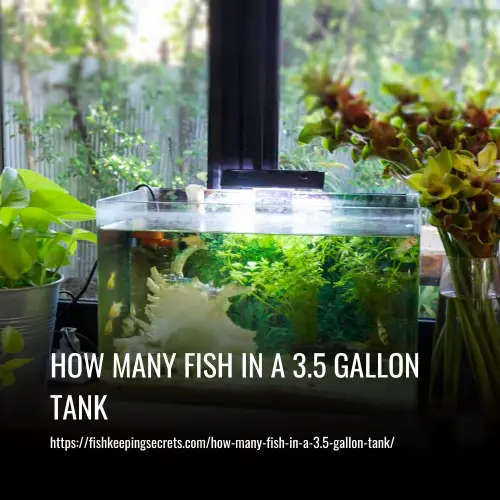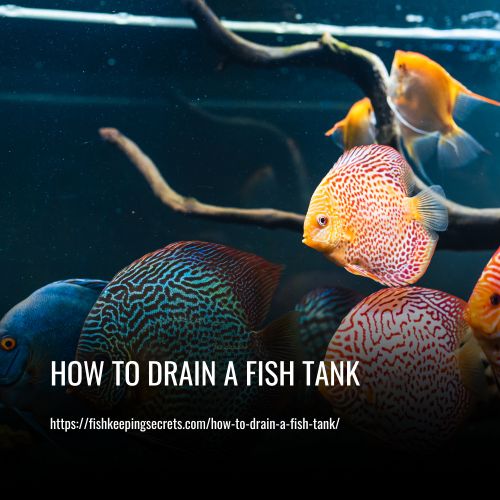Maintaining the proper water parameters in a fish tank is essential for the health and well-being of its inhabitants. One important parameter to monitor is the alkalinity, which measures the ability of the water to neutralize acids. High alkalinity can lead to pH imbalances and negatively impact the health of fish and other aquatic life.
To fix high alkalinity in fish tank, follow these steps:
- 1. Regular Water Changes
- 2. Adding Driftwood
- 3. Introducing Live Plants
- 4. Using Lemon Juice or Vinegar
- 5. Add pH-Lowering Products
- 6. Use Reverse Osmosis (RO) Filter
- 7. Use Peat Moss
- 8. Use Water Softener
- 9. Regularly Test Aquarium Water

How To Lower Alkalinity In Fish Tank
When dealing with high alkalinity in a fish tank, there are several methods you can use to lower it. Here are some effective ways to reduce alkalinity in your fish tank:
1. Regular Water Changes
Performing regular water changes using soft and low mineral water sources like RO water, distilled water, or rainwater can help lower alkalinity. Additionally, cleaning the substrate during water changes can also decrease alkalinity by removing fish waste that contributes to its levels. It’s recommended to conduct small, frequent water changes to prevent shocking the fish.
2. Adding Driftwood
Placing driftwood in your aquarium is another natural way to lower alkalinity. Driftwood releases tannins, which not only reduce alkalinity but also lower the pH level. Make sure to use untreated and natural driftwood for the safety of your fish. Combining driftwood with live plants can enhance their effectiveness in reducing alkalinity over time.
3. Introducing Live Plants
Live plants absorb carbon dioxide and release oxygen, which helps decrease alkalinity in the water. They also aid in maintaining water cleanliness by absorbing nutrients present in the water. Adding diverse plant species can further enhance their ability to lower alkalinity.
4. Using Lemon Juice or Vinegar
An alternative method to lower alkalinity is by adding small amounts of lemon juice or vinegar to the aquarium. These substances are highly acidic, which can effectively reduce alkalinity. However, it’s essential to monitor the pH level and alkalinity carefully when using this method.
5. Add pH-Lowering Products
Look for pH-lowering products specifically designed for aquarium use, such as API pH Down Aquarium PH Freshwater Buffer or Reeflowers Alkaline I Natural Aquarium Minerals. These products help to neutralize alkaline levels in the water by containing acids. Ensure to research the product and its ingredients beforehand, as some may affect water quality or harm your fish. Follow the instructions carefully to avoid pH levels dropping too low.
6. Use Reverse Osmosis (RO) Filter
Utilizing an RO filter is an effective way to lower alkalinity in your tank. This filtration system removes impurities and minerals from water, resulting in clean and low-mineral water, which is ideal for aquarium use. Mix the RO water with your regular tap water to reduce alkalinity levels, as solely using RO water may lack important minerals and nutrients necessary for the health of your fish and plants.
7. Use Peat Moss
Peat moss is a natural way to lower alkalinity in your tank. Place a small amount of peat moss in a bag and put it in your filter. As the water flows through the filter, the peat moss will release tannins that lower the alkalinity. Be aware that peat moss can also lower water hardness and may turn the water brown. If you don’t like the color, you can use activated carbon to clear the water.
8. Use Water Softener
Another effective method is using a water softener. This device removes minerals, including those that cause high alkalinity, from the water. You can install a water-softening system for your entire home or use a portable water-softening device specifically for your tank. There are salt-based and salt-free variations of water softeners. Be cautious with salt-based softeners as they can harm your fish if not used properly. Salt-free softeners use alternative methods, such as carbon filtration, to remove minerals.
9. Regularly Test Aquarium Water
To ensure the alkalinity levels in your tank remain within safe and healthy ranges, it’s important to test the water regularly. Purchase water test kits or an aquarium pH meter from your local pet store to accurately measure alkalinity levels. Factors such as new decorations, changing water sources, or introducing new fish may cause fluctuations in alkalinity. By monitoring and testing the water, you can take appropriate action to maintain optimal alkalinity levels for your fish.
Remember to regularly test the water parameters and monitor the effects of these methods to ensure that the alkalinity remains at an optimal level for the health and well-being of your fish.
What Is Alkalinity In Aquarium Water
Alkalinity in aquarium water refers to the water’s ability to neutralize acids. It is a measure of how resistant the water is to changes in pH. Water with high alkalinity is often called “hard” water and contains a high concentration of minerals like calcium, magnesium, and heavy metals.
These minerals act as buffers, helping to absorb acids and stabilize the pH in the aquarium. Having high alkaline levels in the fish tank water makes it more stable compared to acidic water, which is more prone to fluctuations in pH.
What Should The Alkalinity Be In A Fish Tank
The ideal alkalinity range in a fish tank is between 4 to 8 dKH or 70 to 140 ppm. This range ensures that the water is balanced and provides a suitable environment for the fish. Alkalinity is a measure of the water’s ability to resist changes in pH, and it can be determined by testing the water’s acidity and stability.
The pH level of the water will also affect its alkalinity, with a pH below 7 indicating acidity and a pH above 7 indicating alkalinity. Factors such as chemicals, minerals, plants, decorations, and substrate can affect the water’s pH level and alkalinity.
The specific alkalinity requirements may vary depending on the species of fish in the tank, with freshwater fish generally adapting well to a pH range of 5.5 to 7.5, and saltwater fish preferring a pH of 8.0 to 8.1. It is important to maintain suitable conditions in the tank to ensure the well-being of the fish, including choosing appropriate plants, substrate, and decorations.
What Causes High Alkalinity In Fish Tank
High alkalinity in a fish tank can be caused by several factors. Using tap water to fill the tank, which often contains high mineral levels, can quickly raise alkalinity. Additionally, excessive calcium in a freshwater aquarium, commonly found in tap water, can contribute to high alkalinity.
Overfeeding fish can also lead to high alkalinity as it increases waste production, raising ammonia and nitrite levels, which in turn raises pH levels and alkalinity. It’s important to monitor and control alkalinity levels in order to maintain a healthy and balanced environment for your fish.
Why is it Necessary to Lower the pH in an Aquarium
Maintaining a balanced pH level in an aquarium is vital for the well-being of the fish and other aquatic creatures. Fluctuating pH levels can cause stress and weaken their immune system, making them susceptible to illnesses and even death.
It is crucial to ensure that the pH is within the optimal range for the specific species in your aquarium. If the pH is too high, it is necessary to gradually lower it to create a suitable environment for the aquarium inhabitants.
Alkalinity VS pH In Aquarium
Understanding the difference between alkalinity and pH is crucial for maintaining a healthy aquarium environment.
pH: pH measures the acidity or basicity of the water on a scale of 0-14. A pH value above 7 indicates alkaline conditions. It is important to determine the ideal pH range for your fish species and maintain a stable pH level in the aquarium.
Alkalinity: Alkalinity, also known as Carbonate Hardness (KH), measures the water’s ability to resist changes in pH. It is related to the presence of carbonates and bicarbonates in the water. Alkalinity acts as a buffer, preventing rapid changes in pH and helping to maintain a stable environment for the fish.
How To Measure Alkalinity In Aquarium
To measure the alkalinity in an aquarium, you can use a test kit and a water sample. There are various test kits available that can test all water parameters at once. Simply dip a test strip into the water sample and wait for it to change color. Compare the color changes to a chart provided. Each variation in color indicates a different alkalinity value.
Digital testers are the easiest and most accurate to use, but they only test specific parameters, so you may need to purchase multiple testers for different parameters. Common test kits include freshwater test strips, which can test for high alkalinity levels, presence of nitrites and nitrates, pH level, and water hardness.
What If Alkalinity Becomes Too Low
When alkalinity becomes too low in an aquarium, it can cause instability and make the water too acidic. To raise the alkalinity quickly, you can use a chemical treatment such as sodium bicarbonate (baking soda). However, it’s important to remove your fish from the tank before adding baking soda to protect them from sudden changes.
The general rule for adding baking soda is 1 teaspoon per 5 gallons of water. While this has an immediate effect, it’s best to give it time to work through the whole tank for optimal results. If you’re struggling to balance the water parameters, you may need to perform an emergency cycle to get things back in check, as fluctuations in ammonia and nitrites can also affect the pH.
Can Low Alkalinity Kill Fish
Low alkalinity in fish tank water is not likely to directly kill your fish, but it can lead to sudden pH swings which can be fatal for fish that are sensitive to such changes. These sudden changes in water parameters can cause stress and shock in fish, ultimately leading to death.
Additionally, low alkalinity can indicate a lack of essential minerals in the water that are important for the health of your fish. Long-term exposure to low alkalinity water can have negative effects on the overall health of your fish.
FAQs
Alkalinity is the capacity of water to resist changes in pH and neutralize acidic water. It is often referred to as the “buffering capacity” of a solution. Alkalinity is measured by how much acid is needed to buffer the solution to become neutral or acidic, depending on the desired pH level. Although alkalinity and pH are related, they are not the same water parameter.
pH stands for “power of hydrogen” and measures the acidity or alkalinity of a solution or substance on a scale from 0 to 14. A pH value of 7.0 is considered neutral, with pure water falling in this range. A pH value below 7.0 indicates increasing acidity, while a pH value above 7.0 indicates increasing alkalinity. The pH value is determined by the concentration of hydrogen ions in the solution, with higher concentrations resulting in lower pH values (more acidic) and vice versa.
No, a water conditioner alone does not typically lower alkalinity. However, some water conditioners may contain ingredients specifically designed to lower alkalinity levels. These products are often formulated to remove heavy metals, chloramines, and chlorine from tap water.
Yes, high alkalinity can be harmful to fish in an aquarium. It can make it hard for them to breathe and can stress them out, which can lead to death. It’s important to test the water regularly and lower the alkalinity if it’s too high. High alkalinity can also leave deposits on the walls and equipment of the fish tank, which can be difficult to remove and may cause damage.
To lower alkalinity in a saltwater fish tank properly, you can do regular water changes, use natural driftwood and Indian almond leaves, and add small amounts of vinegar or lemon juice. These methods will help reduce alkalinity and maintain a healthy environment for your fish. Avoid using baking soda, as it will increase alkalinity and raise the pH level.
Maintaining adequate alkalinity levels in your fish tank is important because it ensures the well-being and health of your fish. High alkalinity levels can lead to difficulty breathing and stress for your fish. On the other hand, low alkalinity can be harmful to both fish and plants, especially as it also causes a decrease in pH levels. It is crucial to remember that various factors, such as plants, decorations, substrate, chemicals, and minerals dissolved in the tank water, can affect the pH of the water.
No, it is not possible to lower alkalinity without affecting pH. Alkalinity acts as a buffer for pH and helps to maintain its stability. When alkalinity is lowered, it will also decrease the pH level. Adding acids to reduce alkalinity will also lower the pH level. This is a chemical reaction that cannot be avoided. So, any acid added to water will lower both the alkalinity and pH level.
If your fish tank is too alkaline, it’s important to find the cause and address it. Check if your tap water or elements in the tank are causing high alkalinity. Removing the cause will provide long-term results. In the meantime, you can use acidic solutions to adjust pH levels or perform water changes with low mineral water to lower alkalinity in the short term.
Alkalinity levels in water can remain stable over time, but there are some situations where it can decrease. Factors such as the type of rocks and minerals in the water, rainwater runoff, and the addition of certain chemicals can influence alkalinity levels. If the water becomes more acidic, it can cause the rocks and minerals to dissolve, leading to a decrease in alkalinity.
Lowering the pH of water can lower the alkalinity, but it depends on the specific situation. In general, as pH decreases, alkalinity also decreases. However, there are exceptions to this rule. For example, adding an acidic substance like vinegar to water can lower the pH but not the alkalinity.
Both pH and alkalinity are important for maintaining a stable water environment, but most experts agree that pH is more important. pH levels can fluctuate more rapidly than alkalinity levels and can have a significant impact on fish and other aquatic life. It is crucial to monitor and maintain pH levels to ensure the health and well-being of the aquatic ecosystem.
It is recommended to test the pH of your aquarium at least once a month to ensure the water is balanced and stable for aquatic life. However, it is even better to test the pH every 1-2 weeks to catch any issues early on. This frequent testing can help you detect any problems and take corrective measures in a timely manner.
To use vinegar to lower the pH of your aquarium, start by taking a small amount of water from the tank and letting it settle for 12-18 hours. After that, add drops of white vinegar to the water. Use a pH strip to test the pH level and observe the changes. Take multiple water samples and continue adding drops of vinegar until you reach the desired pH level. The recommended dose of white vinegar is 1ml per gallon of water.
Yes, it is safe to add white vinegar to lower the pH in a freshwater aquarium. It is important to use distilled vinegar with a pH of 2.4 and 5% acetic acid. Before adding vinegar, check the water pH to track changes accurately. The recommended amount of vinegar is 1ml per gallon of water, which can lower the pH by 0.3 levels.
High levels of alkalinity in a fish tank can have harmful effects on the fish. It can damage the mucus layer that protects the fish, making them vulnerable to infections and bacterial attacks. High alkalinity can also cause breathing issues and affect the fins and tails of the fish, which can ultimately lead to their death. It is important to maintain proper alkalinity levels in a fish tank to ensure the health and well-being of the fish.
To monitor the alkalinity and pH change in aquarium water, it’s important to regularly test the water. If you notice any changes in your fish’s behavior, immediately test the pH of the water. If the pH is high, there are several methods you can try to reduce the alkalinity in the fish tank.
When fish are exposed to high levels of alkalinity or pH, they may exhibit behaviors such as rapid swimming, over-excitement, and attempting to jump out of the water. On the other hand, low alkalinity or pH levels can cause fish to hide more than usual, stay in one spot, or appear sluggish. If you notice these behaviors, it is important to check the pH and alkalinity of the water and take steps to correct any imbalances.
Conclusion
In conclusion, maintaining the proper alkalinity level in your fish tank is essential for the health and well-being of your aquatic pets. By regularly testing the alkalinity levels and making adjustments as needed, you can create a stable and suitable environment for your fish to thrive. Whether it’s by using commercial products, water changes, or adding natural materials, there are various methods to lower alkalinity in your fish tank.
It’s important to note that sudden and drastic changes in alkalinity can be stressful for fish, so it’s best to make gradual adjustments over time. Additionally, monitoring other water parameters such as pH, ammonia, and nitrate levels is crucial for overall tank health.



